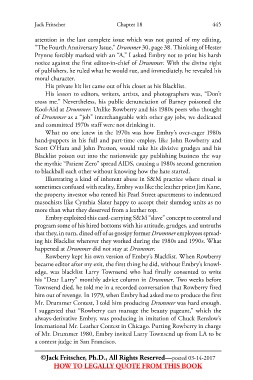Page 463 - Gay Pioneers: How DRUMMER Magazine Shaped Gay Popular Culture 1965-1999
P. 463
Jack Fritscher Chapter 18 445
attention in the last complete issue which was not gutted of my editing,
“The Fourth Anniversary Issue,” Drummer 30, page 38. Thinking of Hester
Prynne forcibly marked with an “A,” I asked Embry not to print his harsh
notice against the first editor-in-chief of Drummer. With the divine right
of publishers, he ruled what he would rue, and immediately, he revealed his
moral character.
His private hit list came out of his closet as his Blacklist.
His lesson to editors, writers, artists, and photographers was, “Don’t
cross me.” Nevertheless, his public denunciation of Barney poisoned the
Kool-Aid at Drummer. Unlike Rowberry and his 1980s peers who thought
of Drummer as a “job” interchangeable with other gay jobs, we dedicated
and committed 1970s staff were not drinking it.
What no one knew in the 1970s was how Embry’s over-eager 1980s
hand-puppets in his full and part-time employ, like John Rowberry and
Scott O’Hara and John Preston, would take his divisive grudges and his
Blacklist poison out into the nationwide gay publishing business the way
the mythic “Patient Zero” spread AIDS, causing a 1980s second generation
to blackball each other without knowing how the hate started.
Illustrating a kind of inherent abuse in S&M practice where ritual is
sometimes confused with reality, Embry was like the leather priest Jim Kane,
the property investor who rented his Pearl Street apartments to indentured
masochists like Cynthia Slater happy to accept their slumdog units as no
more than what they deserved from a leather top.
Embry exploited this card-carrying S&M “slave” concept to control and
program some of his hired bottoms with his attitude, grudges, and untruths
that they, in turn, dined off of as gossipy former Drummer employees spread-
ing his Blacklist wherever they worked during the 1980s and 1990s. What
happened at Drummer did not stay at Drummer.
Rowberry kept his own version of Embry’s Blacklist. When Rowberry
became editor after my exit, the first thing he did, without Embry’s knowl-
edge, was blacklist Larry Townsend who had finally consented to write
his “Dear Larry” monthly advice column in Drummer. Two weeks before
Townsend died, he told me in a recorded conversation that Rowberry fired
him out of revenge. In 1979, when Embry had asked me to produce the first
Mr. Drummer Contest, I told him producing Drummer was hard enough.
I suggested that “Rowberry can manage the beauty pageant,” which the
always-derivative Embry, was producing in imitation of Chuck Renslow’s
International Mr. Leather Contest in Chicago. Putting Rowberry in charge
of Mr. Drummer 1980, Embry invited Larry Townsend up from LA to be
a contest judge in San Francisco.
©Jack Fritscher, Ph.D., All Rights Reserved—posted 03-14-2017
HOW TO LEGALLY QUOTE FROM THIS BOOK

